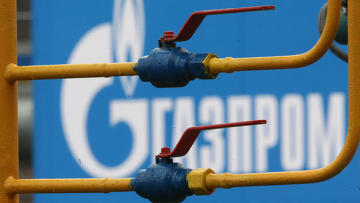
Can Nabucco be Married Off to Gazprom?
Publication: Eurasia Daily Monitor Volume: 7 Issue: 25
By:

Unexpectedly, the US State Department’s Special Envoy for Eurasian energy affairs, Richard Morningstar, seems to embrace the idea of allowing Gazprom to become a user of the Nabucco pipeline. Speaking in Washington at the Center for American Progress (a think-tank associated with left-leaning constituencies in the Obama administration) on January 28, Morningstar suggested inviting Gazprom to use part of the Nabucco pipeline’s capacity, for Russian gas. The suggestion was not included in Morningstar’s prepared speech (https://www.americanprogress.org/events/2010/01/morningstar.html), but came during the question and answer session. The Interfax news agency cited Morningstar’s remark at some length, as follows:
“It may make sense to invite Russia as a supplier country into the Nabucco pipeline. Russia could perhaps supply gas through Blue Stream to Turkey [for Nabucco]. This would make it possible for Russia to participate in the project, not as a controlling party, but as one participant; and considering the global financial situation, this would be a fully rational way to proceed. If we talk about this to the Russians candidly, we may receive interesting answers” (Interfax, January 29).
The Russian rendition does not clarify the proposed form of Gazprom’s participation (whether as a shipper or stakeholder). Meanwhile, Russia faces a widely anticipated gas shortfall (stagnant production versus growing supply commitments), as also recognized already in 2008 by Gazprom itself. This is now hidden from view by falling external and internal demand for gas during the economic recession. But this temporary reprieve will end with the post-recession recovery, when the shortfall will loom again. With its heavy financial indebtedness, moreover, Gazprom is unable to finance new export pipelines, hoping mainly for international funding of its export pipeline projects. Gazprom’s latest board meeting half-admitted to this situation. Nevertheless, it scheduled continuing expansion of pipeline projects, without financing any significant new field development to fill the proposed pipeline capacities (EDM, January 29).
Sharing the Nabucco pipeline’s capacity with Gazprom would practically amount to European financing of pipeline capacity for Russian use, to the extent of Gazprom-booked capacity in Nabucco’s open-season tender (see Nabucco Gas Project Retains Political and Business Momentum, EDM, February 5). On the other hand, should the Kremlin draw on its cash reserves for a portion of Nabucco’s construction costs, it will have defeated this European and Caspian energy security project; and it will have achieved that goal by invitation.
From a supply standpoint, Russia could hardly find extra gas volumes for Nabucco from Russia’s own resources, except perhaps by diverting some volumes via Blue Stream away from another Black Sea country (Ukraine). This theoretical possibility could increase pressure on Ukraine to relinquish control of its gas transit system to Gazprom on penalty of seeing transit volumes diverted away from Ukraine. The South Stream project functions as Russia’s leverage on Ukraine for that purpose, and an expanded use of Blue Stream would add to that leverage against Ukraine.
It also seems highly counterproductive to invite Gazprom into Nabucco before ensuring that Azerbaijan and Turkmenistan obtain access for their gas to the Nabucco pipeline. Otherwise, Gazprom’s gas volumes may preempt the pipeline’s capacities to the detriment of Azerbaijan and Turkmenistan. If these two countries are not connected with Nabucco as a matter of overriding priority, then Russian gas volumes delivered into Nabucco could be volumes bought by Gazprom from those Caspian countries, or swapped with those countries for re-routing into Nabucco.
Nabucco is the centerpiece of the more ambitious Southern Corridor plan, which the United States supports politically. Morningstar reaffirmed that support in his January 28 speech and is known to be working on the diplomatic level to advance the Southern Corridor plan. It would be compromised, however, by inviting Gazprom into Nabucco.
Given the financial and supply hurdles to Gazprom’s participation in this project, conversations about such participation may prove academic. However, some European parties insist that Gazprom cannot be excluded under European law from this project, even though Gazprom is a massive violator of European anti-trust and unbundling laws and regulations on EU territory.
Discussions about Russian participation in Nabucco can produce an effect similar to that of Russian hype of South Stream, generating confusion about EU purposes and policies, and raising more question marks for potential investors in Nabucco as a diversification project. South Stream serves as an anti-diversification project, specifically against Nabucco. US policy supports diversification more consistently than many West European governments and energy champion companies, including those of Austria and Turkey. However, the inclusion of Gazprom in Nabucco could also become an anti-diversification step.
Those proposals, if implemented, would negate the Nabucco project’s strategic rationale, practically turning this project on its head. The rationale has all along been to reduce European dependence –and the Nabucco countries’ overdependence– on Russian gas; and also to forestall the extension of Gazprom-imposed business models and Gazprom-shared control of infrastructure in Europe. Sharing the Nabucco pipeline with Gazprom would defeat those goals.
Nabucco only makes sense as a strategic project of supply security for Europe. It would lose that sense if used as a vehicle for certain companies’ narrow interests (OMV or Turkey’ Botas) in special deals with Gazprom through Baumgarten or Blue Stream. The Nabucco project would also risk forfeiting its raison d’etre, and even feasibility, if entangled politically with the US-Russian “reset.”




